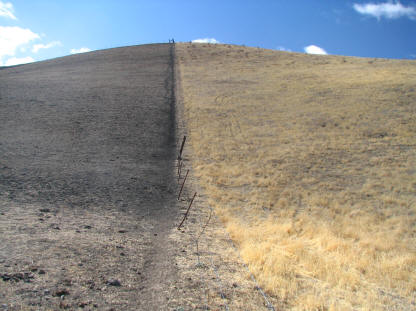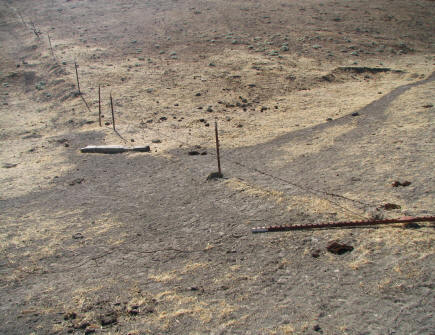Livestock Will Be Removed from Ecological Reserve; State of California Will Complete Land Management Plan
San Luis Obispo County, Calif. – Conservation groups, the State of California, and a livestock operator finalized a formal agreement last week that will protect the 30,000-acre Carrizo Plain Ecological Reserve from severe livestock overgrazing. The legal agreement mandates removal of all livestock from the Reserve until environmental studies are completed, and calls for the preparation of a long-term management plan for the Reserve, which is located between the Los Padres National Forest and the Carrizo Plain National Monument in southeastern San Luis Obispo County.

Overgrazed area (left) and ungrazed area (right) on the Carrizo Plain Ecological Reserve, October 2009
The agreement resolves a lawsuit filed in February 2010 by Los Padres ForestWatch and the Santa Lucia Chapter of the Sierra Club. The suit was brought after visitors to the Reserve witnessed and reported excessive livestock grazing and severe environmental damage. In some areas of the Reserve, improperly managed livestock had removed nearly all vegetation from hundreds of acres of wildlife habitat, trampled natural springs, and caused terracing and severe erosion on hillsides. In addition, fences were in disrepair, allowing livestock to enter areas specifically off-limits to grazing.
“We’re pleased that all parties could come together and agree on an approach that will best protect Reserve lands,” said Jeff Kuyper, executive director of Los Padres ForestWatch, a nonprofit land conservation organization based in Santa Barbara that works to protect the Los Padres National Forest and the Carrizo Plain. “This agreement will protect the Reserve from additional damage, while setting in motion a process to guide the long-term restoration of these critically important lands.”
The lawsuit alleged that these improper grazing practices violated the terms and conditions of a grazing lease issued to Dr. Neal Dow of Prineville, Oregon. The California Department of Fish and Game (CDFG) – the agency charged with managing the Reserve – issued the lease in 2006, and renewed it in 2009, allowing Dr. Dow to graze 3,600 cows on the Reserve each year through 2012. The Department issued and renewed the lease without notifying the public or preparing any environmental studies, as required by the California Environmental Quality Act. The lawsuit also alleged that the CDFG violated state law by failing to prepare a legally-mandated management plan for the Reserve.
Under the terms of the legal agreement, which was approved by the Superior Court in San Francisco last week, the Department agreed to take the following steps to protect the Reserve:
- The CDFG will immediately give notice to Dr. Dow terminating the grazing lease. The termination is effective in 90 days, and under the terms of the lease, Dr. Dow is given an additional 90 days to completely remove his livestock from the Reserve.
- Before any new grazing lease is issued for the Reserve, the CDFG will prepare an Initial Study under the California Environmental Quality Act (CEQA), and will use that study to determine whether to prepare a more detailed Environmental Impact Report. The Initial Study will be released for public review and comment.
- The Department agreed to not allow any livestock grazing on the Reserve until the CEQA process is complete.
- The Department agreed to make a good faith effort to prepare a draft Land Management Plan for the Reserve by August 2011 and a final plan by March 2012.
“The Department of Fish and Game was entrusted with the care of this land by the people of California,” said Andrew Christie, director of the Sierra Club’s Santa Lucia Chapter. “They couldn’t be allowed to circumvent the law in order to permit a destructive practice in an ecological reserve.”
The Reserve includes more than 30,000 acres of ecologically sensitive habitat linking the Los Padres National Forest and the Carrizo Plain National Monument. The State of California established the Reserve in 2002 and expanded it in 2004 with $12.7 million in wildlife and clean water funds approved by voters. The Water Security, Clean Drinking Water, Coastal and Beach Protection Fund of 2002 (commonly known as Proposition 50) authorized the sale of bonds “to protect regional water quality, protect and enhance fish and wildlife habitat, and to assist local public agencies in improving regional water supply reliability.” A portion of the funds used to acquire and expand the Reserve also came from the Habitat Conservation Fund, which was established for the “acquisition of habitat to protect rare, endangered, threatened, or fully protected species.” In applying for funds in 2004, the CDFG stated that the proposed use of the acquired lands would be for the “[p]rotection and preservation of wildlife habitat.”
The Reserve contains rare blue oak woodlands and native grasslands as well as some of the region’s only populations of Tule elk and pronghorn antelope. The Reserve also provides habitat for at least 58 threatened, endangered, and other protected species including burrowing owl, San Joaquin kit fox, southwestern pond turtle, California red-legged frog, grasshopper sparrow, and tri-colored blackbird.
The lawsuit – Los Padres ForestWatch et al. v. California Department of Fish & Game – and subsequent settlement agreement were filed in Superior Court in San Francisco. Plaintiffs Los Padres ForestWatch and Sierra Club were represented by attorneys Sharon Duggan of Oakland and Michael Graf of El Cerrito.

Fence in disrepair, allowing cattle to graze in prohibited areas Carrizo Plain Ecological Reserve, October 2009








Comments are closed.